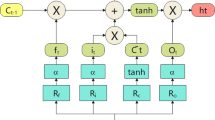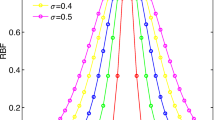Abstract
Wind energy has become one of the most efficient renewable energy sources. However, the wind has the characteristics of intermittence and uncontrollability, so it is challenging to predict wind speed accurately. Considering the shortcomings of traditional wind power point predictions, a new hybrid model comprised three main modules used for data preprocessing, deterministic point prediction, and interval prediction is proposed to predict the wind speed interval. The first module, the data preprocessing module, uses variational mode decomposition (VMD), sample entropy (SE), and singular spectrum analysis (SSA) to extract the different frequency components of the initial wind speed series. The second module, the deterministic point prediction module, uses extreme learning machines (ELM), and a gated recursive unit (GRU) model to perform point prediction on the wind speed series. The third module, the interval prediction module, uses the nonparametric kernel density estimation method to construct the upper and lower bounds of the wind speed interval. In addition, the final wind speed prediction interval is obtained by integrating the prediction results of multiple interval prediction results to improve the robustness and generalization of the wind speed interval prediction. Finally, the effectiveness of the prediction performance of the proposed hybrid model is verified based on the data of two actual wind farms. The experimental results show that the proposed hybrid model can obtain the appropriate wind speed interval with high confidence and quality with different confidence levels of 95%, 90%, and 85%.













Similar content being viewed by others
Data availability
The datasets used or analyzed during the current study are available from the corresponding author on reasonable request.
References
Antonio B, Guido C, Pasquale DF (2017) A probabilistic competitive ensemble method for short-term photovoltaic power forecasting. IEEE Trans Sustain Energy 8(2):551–560
Dragomiretskiy K, Zosso D (2014) Variational mode decomposition. IEEE Trans Signal Process 62(3):531–544
Dhiman HS, Deb D, Guerrero JM (2019) Hybrid machine intelligent SVR variants for wind forecasting and ramp events. Renew Sust Energ Rev 108:369–379
Ding M, Zhou H, Xie H, Wu M, Nakanishi Y, Yokoyama R (2019) A gated recurrent unit neural networks based wind speed error correction model for short-term wind power forecasting. Neurocomputing 365(6):54–61
Ding W, Meng F (2020) Point and interval forecasting for wind speed based on linear component extraction. Appl Soft Comput 93(1):106350
Eldakkak O, Feng S, Wahbah M, Elfouly T, Zahawi B (2019) Combinatorial method for bandwidth selection in wind speed kernel density estimation. IET Renew Power Gener 13:1670–1680
Feng C, Cui MJ, Hodge BM, Zhang J (2017) A data-driven multi-model methodology with deep feature selection for short-term wind forecasting. Appl Energy 190:1245–1257
Han Q, Hao Z, Hu T, Chu F (2018) Non-parametric models for joint probabilistic distributions of wind speed and direction data. Renew Energy 126:1032–1042
Hu QH, Zhang RJ, Zhou YC (2016) Transfer learning for short-term wind speed prediction with deep neural networks. Renew Energy 85:83–95
Huang XJ, Wang JZ, Huang BQ (2021) Two novel hybrid linear and nonlinear models for wind speed forecasting. Energy Convers Manag 238:114162
Jadaan OA, Rajamani L, Rao CR (2006) Parametric study to enhance genetic algorithm performance, using ranked based roulette wheel selection method
Jahangir H, Golkar MA, Alhameli F, Mazouz A, Ahmadian A, Elkamel A (2020) Short-term wind speed forecasting framework based on stacked denoising auto-encoders with rough ANN. Sustain Energy Technol Assess 38:100601
Juban J, Siebert N, Kariniotakis GN (2007) Probabilistic short-term wind power forecasting for the optimal management of wind generation. Power Tech, 2007 IEEE Lausanne. IEEE
Kavousi-Fard A, Khosravi A, Nahavandi S (2015) A new fuzzy-based combined prediction interval for wind power forecasting. IEEE Trans Power Syst 31(1):18–26
Khosravi A, Nahavandi S, Creighton D, Atiya AF (2011) Comprehensive review of neural network-based prediction intervals and new advances. IEEE Trans Neural Netw 22:1341–1356
Kim M, Park S, Lee J, Joo Y, Choi JK (2017) Learning-based adaptive imputation methodwith kNN algorithm for missing power data. Energies 10(10):1668
Li CS, Tang G, Xue XM, Chen XB, Wang RH, Zhang C (2019) Deep interval prediction model with gradient descend optimization method for short-term wind power prediction. Syst Control:1–24
Li R, Yu J (2018) A wind speed interval prediction system based on multi-objective optimization for machine learning method. Appl Energy 228:2207–2220
Liu FJ, Li CS, Xu YH, Tang G, Xie YY (2020) A new lower and upper bound estimation model using gradient descend training method for wind speed interval prediction. Wind Energy 24:290–304
Liu X, Cao ZM, Zhang ZJ (2021a) Short-term predictions of multiple wind turbine power outputs based on deep neural networks with transfer learning. Energy 217:119356
Liu XL, Lin Z, Feng ZL (2021b) Short-term offshore wind speed forecast by seasonal ARIMA — a comparison against GRU and LSTM. Energy 227:120492
Luo X, Sun JK, Wang L, Wang WP, Zhao WB, Wu JS, Wang JH, Zhang ZJ (2018) Short-term wind speed forecasting via stacked extreme learning machine with generalized correntropy. IEEE Trans Indust Inform 14:4963–4971
Memarzadeh G, Keynia F (2020) A new short-term wind speed forecasting method based on fine-tuned LSTM neural network and optimal input sets. Energy Convers Manag 213:112824
Moreno SR, Silva RGD, Mariani VC, Coelho LDS (2020) Multi-step wind speed forecasting based on hybrid multi-stage decomposition model and long short-term memory neural network. Energy Convers Manag 213:112869
Ni Q, Zhuang SX, Sheng HM, Kang GQ, Xiao J (2017) An ensemble prediction intervals approach for short-term PV power forecasting. Sol Energy 155:1072–1083
Peng ZY, Peng S, Fu LD, Lu BC, Tang JJ, Wang K, Li WY (2020) A novel deep learning ensemble model with data denoising for short-term wind speed forecasting. Energy Convers Manag 207:112524
Qi MH, Gao HJ, Wang LF, Xiang YM, Lv L (2020) Wind power interval forecasting based on adaptive decomposition and probabilistic regularised extreme learning machine. IET Renew Power Gen 14(16):3181–3191
Sun N, Zhou JZ, Chen L, Jia BJ, Tayyab LM, Peng T (2018) An adaptive dynamic short-term wind speed forecasting model using secondary decomposition and an improved regularized extreme learning machine. Energy 165:939–957
Tang G, Wu Y, Li C, Wong PK, Xiao ZH, An XL (2020) A novel wind speed interval prediction based on error prediction method. IEEE Trans Indust Inform 16(11):6806–6815
Wang JZ, Hu JM, Ma KL (2016a) Wind speed probability distribution estimation and wind energy assessment. Renew Sust Energ Rev 60:881–899
Wang SX, Zhang N, Wu L, Wang YM (2016b) Wind speed forecasting based on the hybrid ensemble empirical mode decomposition and GA-BP neural network method. Renew Energy 94:629–636
Xu HY, Chang YQ, Wang FL, Wang S, Yao Y (2021a) Univariate and multivariable forecasting models for ultra-short-term wind power prediction based on the similar day and LSTM network. J Renew Sustain Energy
Xu HY, Chang YQ, Wang FL, Wang S, Yao Y (2021b) A hybrid model for multi-step wind speed forecasting based on secondary decomposition, deep learning, and error correction algorithms. J Intell Fuzzy Syst 41:3443–3462
Yu CJ, Li YL, Zhang MJ (2017) An improved wavelet transform using singular spectrum analysis for wind speed forecasting based on elman neural network. Energy Convers. Manage 148:895–904
Yu WB, Zhao FY (2019) Predictive study of ultra-low emissions from dual-fuel engine using artificial neural networks combined with genetic algorithm. Intl J Green Energy 16:938–946
Zhang C, Zhou JZ, Li CS, Fu WL, Peng T (2017) A compound structure of ELM based on feature selection and parameter optimization using hybrid backtracking search algorithm for wind speed forecasting. Energy Convers Manag 143:360–376
Zhang L, Xie L, Han QK, Wang ZL (2020) Probability density forecasting of wind speed based on quantile regression and kernel density estimation. Energies. 13(22):6125
Zhao J, Guo ZH, Guo YL, Lin WT, Zhu WJ (2021) A self-organizing forecast of day-ahead wind speed: Selective ensemble strategy based on numerical weather predictions. Energy 218:119509
Zhu S, Yuan XH, Xu ZY, Luo XG, Zhang HR (2019) Gaussian mixture model coupled recurrent neural networks for wind speed interval forecast. Energy Convers Manag 198:111772
Acknowledgements
The authors thank State Grid Liaoning Electric Power Co., Ltd for collaboration on providing wind speed data.
Funding
This work was funded by the National Natural Science Foundation of China (Nos. 61873053 and 61973057) and the National Key Research and Development Program of China (Nos. 2019YFE0105000).
Author information
Authors and Affiliations
Contributions
XH: idea, data gathering, writing–original draft preparation, methodology, software. CY: investigation, draft reviewing, editing, supervision. ZY: methodology, software. WF draft reviewing, editing.
Corresponding author
Ethics declarations
Ethics approval and consent to participate
Not applicable.
Consent for publication
Not applicable.
Competing interests
The authors declare no competing interests.
Additional information
Responsible Editor: Marcus Schulz
Publisher’s note
Springer Nature remains neutral with regard to jurisdictional claims in published maps and institutional affiliations.
Rights and permissions
About this article
Cite this article
Xu, H., Chang, Y., Zhao, Y. et al. A novel hybrid wind speed interval prediction model based on mode decomposition and gated recursive neural network. Environ Sci Pollut Res 29, 87097–87113 (2022). https://doi.org/10.1007/s11356-022-21904-5
Received:
Accepted:
Published:
Issue Date:
DOI: https://doi.org/10.1007/s11356-022-21904-5




